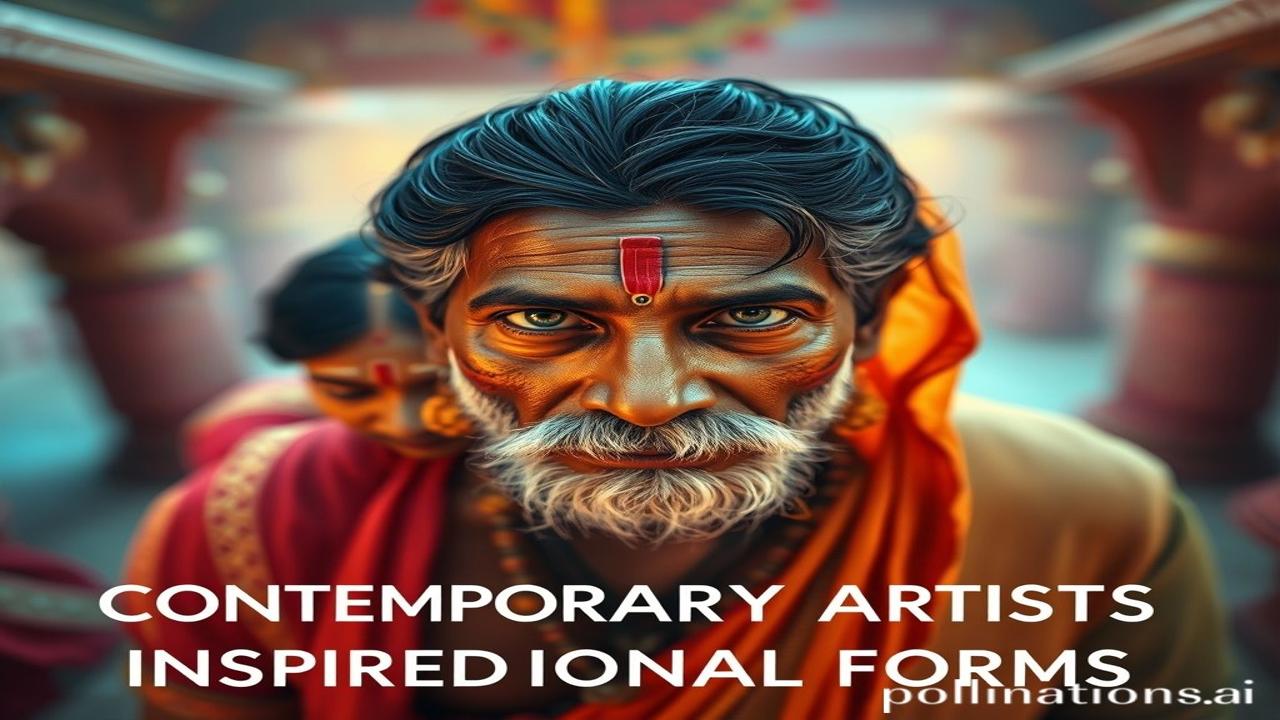Waqt Ki Dhool Mein: Contemporary Artists, Traditional Forms – A Love Story
Kabhi aankhein band karke socho… woh geet jo dadi maa raat ko sunati thi, woh rangoli jo Diwali pe banti thi, woh kathputli ka naach jo gaon ke mele mein dikhta tha. Kahan gaye woh din? But, dosto, kya tum jaante ho ki woh kahaniyan, woh kala, abhi bhi zinda hai? Bas, thoda naye andaaz mein, naye canvas pe. Today, we’re diving into the fascinating world of contemporary artists who are taking inspiration from our traditional forms. Let’s explore this beautiful bridge between the past and the present.
Bharat Ki Kalatmak Parampara: Ek Jhalak (A Glimpse into India’s Artistic Traditions)
What are we talking about? Think of it as a revival, a reimagining. For centuries, India has been a land of incredible artistic diversity. From Madhubani paintings in Bihar to Warli art in Maharashtra, from the classical dance forms like Bharatanatyam and Kathak to the folk music echoing in Rajasthan’s deserts, our culture is dharohar – a treasure trove.
These traditions weren’t just decorative; they were a way of life. They told stories, conveyed values, celebrated seasons, and connected people to the divine. Dating back thousands of years, many of these art forms were developed in specific regions, often passed down through generations within families or communities. Think about the intricate bronze sculptures of the Chola dynasty (around the 9th-13th centuries), or the Mughal miniatures that depicted courtly life in the 16th-18th centuries. Each brushstroke, each mudra, each note, carried a deep cultural meaning. But, with the passage of time, these traditions faced challenges – modern influences, lack of patronage, and a changing world.
Zameeni Sach: Kala Aur Jeevan (Art and Life on the Ground)
Imagine Ma Durga Bai, an artist from the Gond tribe in Madhya Pradesh. Her world is filled with vibrant colours and fantastical creatures – tigers with peacock feathers, trees that bear stories, and gods that dance with mortals. For her, painting isn’t just a hobby; it’s a way to connect with her ancestors, to share her tribe’s mythology, and to celebrate the beauty of the natural world.
Or picture Ustad Zakir Hussain, a master of the tabla. He isn’t just playing notes; he’s channeling centuries of rhythmic tradition, improvising with a spirit of innovation that keeps the music alive. He might be collaborating with jazz musicians one day and teaching students in a remote village the next, ensuring that the heartbeat of Indian classical music continues to resonate.
“Beta, yeh kala humare khoon mein hai,” Ma Durga Bai might say, her eyes twinkling. “Yeh sirf rang nahin hai, yeh humari pahchan hai.” (Son, this art is in our blood. It’s not just colours, it’s our identity.)
Dharohar Aur Pahchan: Aaj Ka Bharat (Cultural Significance Today: Modern India)
Today, you see this inspiration everywhere. Fashion designers are incorporating traditional weaves and embroidery into contemporary garments. Musicians are fusing classical ragas with electronic beats. Filmmakers are drawing on ancient epics for their storylines. Artists are using traditional techniques to create modern installations and sculptures.
This isn’t just about preserving the past; it’s about creating something new and relevant for the present. It’s about reaffirming Bharatiyata – our Indianness – in a world that’s becoming increasingly homogenized. This fusion allows us to understand our roots while reaching for the sky. It strengthens our cultural identity and gives it a new voice in the global conversation.
Mazedar Tathya Ya Bhram-Bhanjak (Fun Fact or Myth-Buster)
Log samajhte hain ki “traditional” ka matlab “purana” aur “boring” hai. Lekin asli sach yeh hai that these traditions are incredibly dynamic and adaptable. Contemporary artists are proving that tradition can be cool, edgy, and totally relevant to the 21st century. They are using it to address social issues, explore personal identities, and challenge conventional norms.
Another myth? That traditional art is only for the elite. In reality, many of these art forms originated amongst common people and were a vital part of their daily lives. Contemporary artists are now working to make these traditions more accessible to everyone, breaking down barriers and fostering a sense of inclusivity.
Drishya Aur Bhavnayein: Ek Anubhav (Visual and Sensory Layer: An Experience)
Imagine the smell of sandalwood incense wafting through the air as a dancer performs a Bharatanatyam recital, her feet pounding the stage in perfect rhythm. Feel the smooth texture of a handwoven silk sari adorned with intricate embroidery. Hear the soulful strains of a shehnai echoing through a bustling marketplace. See the vibrant colours of a Madhubani painting come to life on a modern mural.
These are the sensory experiences that connect us to our cultural heritage. They evoke emotions, memories, and a sense of belonging. They remind us that art is not just something we see; it’s something we feel, smell, hear, and touch.
Antim Vichar Ya Uddharan (Closing Insight or Quote)
“संस्कृतिः जीवनादर्शः।” (Sanskrit: Sanskritihi jeevanadarshah) – Culture is the ideal of life.
The contemporary artists who are drawing inspiration from our traditional forms are not just creating art; they are preserving our culture, reaffirming our identity, and enriching our lives. They are reminding us that the past is not just a distant memory; it’s a living force that continues to shape our present and inspire our future. Let’s celebrate their work and ensure that these beautiful traditions continue to thrive for generations to come.
